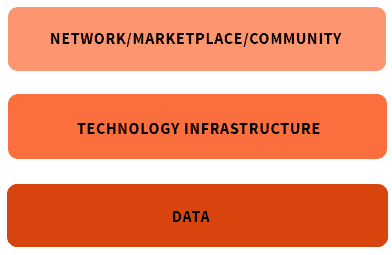Concepts
10 startup business puzzles visualized through the platform stack
Startup Strategies: Competition and Coexistence
In an earlier essay and whitepaper, we used the platform stack to explain the workings of different platforms.
Through the slides embedded below, I’d like to use the platform stack to illustrate competition and coexistence of platforms in different verticals.
Through the story presented in these slides, we look at a few startup moves and try to understand how different platforms compete and coexist by focusing on different layers of the stack. Some of the moves that these slides explore include the following:
- How Airbnb beat Craigslist
- Why Mint.com and Quicken have fundamentally different business model design
- Why Facebook’s photos application became so popular
- The success of the app store model in building developer ecosystems
- LinkedIn’s superior business model and Monster’s failure to keep up
- Facebook’s success with building a ‘deeper’ platform than Myspace
- How YouTube and Vimeo continue to coexist
- Why Medium is so powerful for writers
The platform stack is a key framework for understanding how platform business models leverage user and partner contributions towards a new form of scale.
Feel Free to Share
Download
Download Our Insights Pack!
- Get more insights into how companies apply platform strategies
- Get early access to implementation criteria
- Get the latest on macro trends and practical frameworks
Revisiting the Platform Stack
Let’s revisit the three key roles of the platform business model:
1.Architecting incentives that repeatedly pull these participants to the platform,
2.Providing a central infrastructure on which participants create and exchange value,
3.Matching participants with each other and with content/goods/services created on the platform
Across all platforms, we repeatedly see three layers, as follows:

Network/Marketplace/Community Layer: Some platforms may have users explicitly connecting with each other, as in social networks. Some may have users not connecting but exchanging items as in marketplaces. And some platforms may have an implicit community layer. E.g. If you use the Nest Thermostat or Mint.com, your usage is benchmarked against others.
Infrastructure Layer: This is what you ‘build’. Of itself, it has little value unless users and partners create value on top. External producers build on top of this infrastructure. On Android, developers build apps. On YouTube, video creators host videos. On ebay, sellers build/host product availability.
Data Layer: The final layer is the data layer. Every platform uses data in some way. But in some cases, the data layer may play a more dominant role than in others. In most cases, data serves to provide relevance, matching the most relevant content/goods/services with the right users.
Platform Scale
The platform stack is a key framework for understanding how platform business models leverage user and partner contributions towards a new form of scale. If you’d like to learn more about it, check out the book ‘Platform Scale’ on the link below.
State of the Platform Revolution
The State of the Platform Revolution report covers the key themes in the platform economy in the aftermath of the Covid-19 pandemic.
This annual report, based on Sangeet’s international best-selling book Platform Revolution, highlights the key themes shaping the future of value creation and power structures in the platform economy.
Themes covered in this report have been presented at multiple Fortune 500 board meetings, C-level conclaves, international summits, and policy roundtables.
Subscribe to Our Newsletter














